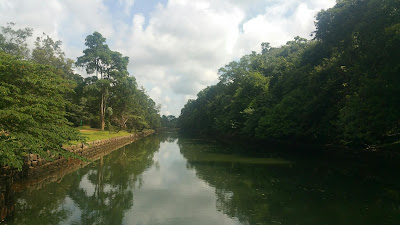Sri Lanka: Sigiriya Lion Rock
Probably the most visited place in Sri Lanka, let's take a peak at this ancient rock fortress located in the northern Matale district between the town of Dambulla and Habarane in the Central Province of Sri Lanka. The Sigiriya(see-gih-REE-yah) Citadel which also refers as Sīhāgiri – Lion Rock.
This archaeological rock occupies an area of approximately two and a half kilometers in length by one kilometer in width. Formed from magma of an extinct volcano, built around the massive 200 meter tall Sigiriya Rock. It was resplendent with gardens, ponds, pavilions and palaces.
What is there to see?
1. Garden landscape
The Gardens of the Sigiriya city are one of the most important aspects of the site, as it is among the oldest landscaped gardens in the world. You will be greeted with gate entrances, water gardend, boulder gardens, water fountains and ponds.
2. Sigiriya frescoes
Impressive graffiti of half naked Sigiriya maidens, intricately painted in the walls 100 meter above the ground more than 15 centuries ago.
Note: Camera and videos are strictly prohibited in this area
3. Lion Paw's terrace and Staircase that leads you to the summit palace area.
4. Mirror wall
Large staircases leads to The Mirror Wall built over fifty meters up the vertical side of Sigiriya Rock. Once gleamed by the sun light, its surface polished into such a fine that you could see your reflection in it.
What is there to see?
1. Garden landscape
The Gardens of the Sigiriya city are one of the most important aspects of the site, as it is among the oldest landscaped gardens in the world. You will be greeted with gate entrances, water gardend, boulder gardens, water fountains and ponds.
2. Sigiriya frescoes
Impressive graffiti of half naked Sigiriya maidens, intricately painted in the walls 100 meter above the ground more than 15 centuries ago.
Note: Camera and videos are strictly prohibited in this area
3. Lion Paw's terrace and Staircase that leads you to the summit palace area.
4. Mirror wall
Large staircases leads to The Mirror Wall built over fifty meters up the vertical side of Sigiriya Rock. Once gleamed by the sun light, its surface polished into such a fine that you could see your reflection in it.
But aside from the magnificent architecture and ruins what fascinates me more is the historical legend behind this Eighth Wonder of the World.
According to the ancient Sri Lankan chronicle the Culavamsa, this site was selected by King Kasyapa (477 – 495 CE) for his new capital. He built his palace on the top of this rock and decorated its sides with colourful frescoes. On a small plateau about halfway up the side of this rock he built a gateway in the form of an enormous lion. The name of this place is derived from this structure —Sīhāgiri, the Lion Rock. The capital and the royal palace was abandoned after the king's death. It was used as a Buddhist monastery until the 14th century.
The Culavamsa describes King Kashyapa as the son of King Dhatusena. Kashyapa murdered his father by walling him up alive and then usurping the throne which rightfully belonged to his half-brother Moggallana, Dhatusena's son by the true queen. Moggallana fled to India to escape being assassinated by Kashyapa, but vowed revenge. In India he raised an army with the intention of returning and retaking the throne of Sri Lanka, which he considered to be rightfully his. Expecting the inevitable return of Moggallana, Kashyapa is said to have built his palace on the summit of Sigiriya as a fortress as well as a pleasure palace. Moggallana finally arrived, declared war, and defeated Kashyapa in 495 CE. During the battle Kashyapa's armies abandoned him and he committed suicide by falling on his sword.
The Culavamsa and folklore inform us that the battle-elephant on which Kashyapa was mounted changed course to take a strategic advantage, but the army misinterpreted the movement as the king's having opted to retreat, prompting the army to abandon him altogether. It is said that being too proud to surrender he took his dagger from his waistband, cut his throat, raised the dagger proudly, sheathed it, and fell dead. Moggallana returned the capital to Anuradhapura, converting Sigiriya into a Buddhist monastery complex, which survived until the 13th or 14th century. After this period, no records are found on Sigiriya until the 16th and 17th centuries, when it was used briefly as an outpost of the Kingdom of Kandy. [Wikipedia]















Comments